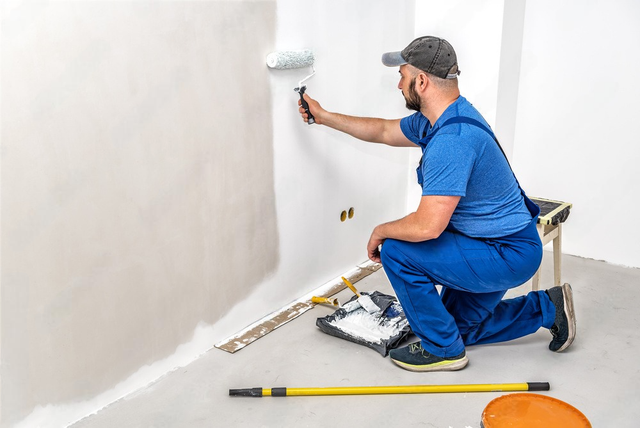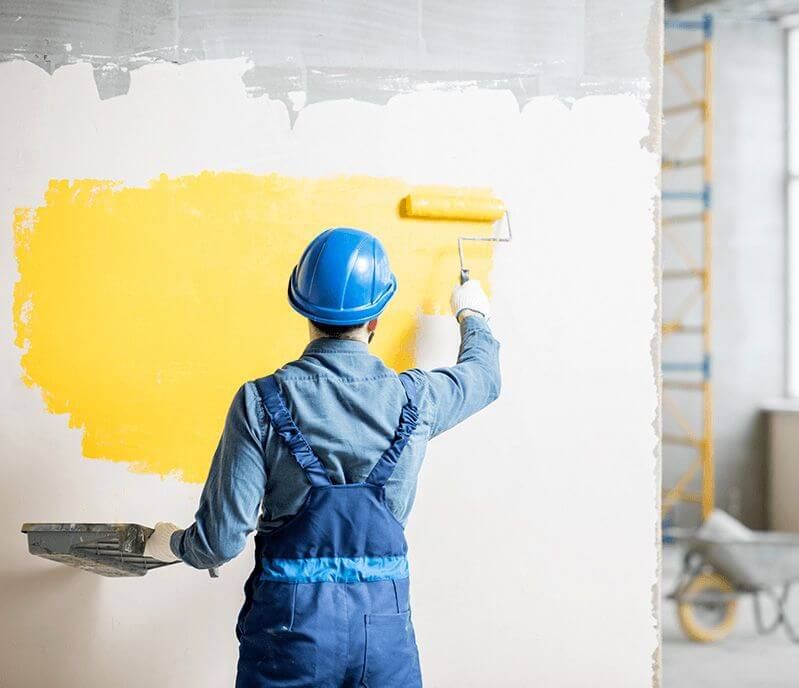Checking Out the Different Kinds Of Paint: A Guide for Every Job
Discovering the numerous kinds of paint is essential for accomplishing the desired end result in any kind of project. From water-based choices that supply convenience to oil-based paints understood for their longevity, each choice has its values. Specialty paints can add one-of-a-kind appearances or finishes, while eco-friendly choices deal with those seeking sustainability. Recognizing these differences can substantially affect the success of a paint undertaking. What variables should one consider when making the right choice?
Recognizing Paint Types: Water-Based vs. Oil-Based
Paint types can markedly impact a project's end result, and understanding the distinctions between oil-based and water-based paints is vital for educated decision-making. Water-based paints, usually referred to as latex paints, are made up of water as the main solvent. They completely dry quickly, release fewer volatile natural compounds (VOCs), and are easy to tidy up with soap and water. This makes them a prominent choice for indoor applications and atmospheres where air high quality is a problem.
In contrast, oil-based paints utilize organic solvents, supplying a durable, glossy finish perfect for surfaces revealed to damage, such as trim and closets. They take longer to dry, call for mineral spirits for cleaning, and have a more powerful odor. corpus christi tx paint shop. Picking between these two kinds depends upon the particular needs of the job, thinking about aspects such as wanted surface, application setting, and ease of maintenance. Each type has distinct advantages and restrictions, directing the selection process
The Complete Issues: Selecting Between Matte, Satin, and Gloss
When choosing a paint surface, the selection between matte and shiny options significantly influences both aesthetic appeals and functionality. Matte surfaces supply a refined, non-reflective appearance that can hide surface area imperfections, while shiny surfaces provide sturdiness and simplicity of cleaning. Understanding the benefits and factors to consider of each can assist in making an educated choice for any paint task.
Matte Complete Advantages
Although lots of property owners question the advantages of numerous finishes, matte paint provides unique advantages that make it a popular selection for both exterior and interior applications. One of the key advantages of matte finish is its capacity to conceal surface flaws, creating a smoother appearance on wall surfaces. This high quality is particularly useful in older homes or rooms with uneven surface areas. In addition, matte paint absorbs light instead of showing it, which can improve the visual of an area by giving a much more muted and sophisticated look. In addition, matte finishes are commonly simpler to retouch than glossier alternatives, as they can blend a lot more seamlessly when applied over existing paint. In general, matte paint is an excellent option for those seeking a fine-tuned and sophisticated coating.
Shiny Finish Considerations
A glossy finish can considerably alter the assumption of a space, using a streamlined and reflective quality that enhances both color vibrancy and light within a room. This coating is often favored for high-traffic areas and surface areas like kitchen areas and shower rooms, where resilience and simplicity of cleaning are vital. Its reflective nature can highlight flaws on wall surfaces, making correct surface area prep work vital. Glossy paints also often tend to show spots and fingerprints more conveniently, necessitating routine maintenance. Additionally, lighting plays a considerable function; in intense settings, a shiny coating might produce glare, affecting the general visual. As a result, mindful consideration of the particular application and setting is necessary when picking a glossy finish for any kind of job.
Specialized Paints: When to Utilize Textured or Chalk Paint
Specialty paints, such as distinctive and chalk paint, deal special aesthetic and sensible benefits that can enhance different surface areas. Distinctive paint is optimal for producing deepness and measurement on walls, concealing flaws while including a three-dimensional feeling. It is particularly useful in high-traffic locations where resilience and aesthetic rate of interest are vital.

Both sorts of specialized paints can transform spaces, but choosing the right one relies on the wanted result and surface area needs. Distinctive paint might fit bigger areas, while chalk paint can revitalize smaller items, showcasing imagination and personal design in any type of project.
Exterior Paints: Shielding Your Surface Areas From the Aspects
Exterior paints are necessary for safeguarding surface areas versus numerous weather conditions. Understanding their weather condition resistance attributes, appropriate surface area prep work requirements, and efficient application methods can greatly enhance resilience and performance. This area will certainly describe crucial factors to consider for picking and using outdoor paints properly.
Weather Condition Resistance Features
Climate resistance is a necessary function of outdoor paints, as it figures out exactly how well surface areas can stand up to the harsh aspects of nature. Top notch exterior paints are developed to resist damage from UV rays, dampness, and temperature level changes. UV resistance guarantees shades remain lively gradually, protecting against fading and staining. Wetness resistance safeguards against mold and mildew and mildew, which can compromise the stability of surface areas. In addition, paints with superb temperature level resistance can increase and contract without cracking, keeping their protective high qualities. When selecting exterior paints, it is essential to think about these climate resistance functions, as they add to the durability and toughness of colored surfaces, making certain they remain visually pleasing and practical despite direct exposure to the aspects.
Surface Preparation Requirements
Correct surface area prep work is a fundamental action in achieving the very best outcomes with outside paints. To ensure perfect adhesion and longevity, surface areas have to be extensively cleansed, eliminating mold, oil, and dirt. This can be accomplished using a stress washer or a scrub brush with an appropriate cleaning service. When cleaned up, surfaces should be evaluated for any peeling or flaking paint, which must be scraped away to produce a smooth foundation. Repairing any kind of openings or splits is also essential, as these can allow dampness seepage. Furthermore, fining sand rough locations advertises far better paint attachment. Applying a guide fit for exterior use can boost the paint's efficiency, assuring a resilient finish that holds up against the elements. Correct preparation is crucial to an effective exterior painting job.
Application Strategies Tips
While applying outdoor paints, it is necessary to utilize effective strategies that assure surfaces are well-protected against the components. Pick the best day for paint; low moisture and mild temperature levels enhance attachment and drying out. Prepping the surface area completely-- cleansing, fining sand, and priming-- guarantees far better paint bond and longevity. Utilizing high-quality brushes or rollers can give a smoother finish, while spray painting might cover large locations successfully. Applying paint in thin, also layers prevents drips and runs. It is suggested to follow maker directions relating to drying out times in between coats. Ultimately, verify appropriate air flow during application to help with drying and decrease direct exposure to fumes. These methods greatly enhance the longevity and performance of exterior paint.
Eco-Friendly Options: Low-VOC and Zero-VOC Paints
As customers become significantly aware of the ecological influence of their selections, zero-voc and low-voc paints have arised as preferred alternatives. These paints are formulated to consist of less volatile organic substances (VOCs), which are chemicals that can evaporate right into the air and add to air contamination and illness. Low-VOC paints normally consist of a restricted amount of VOCs, while zero-VOC paints have negligible levels, making them more secure for both outside and indoor use.
The benefits of making use of zero-voc and low-voc paints expand beyond ecological considerations; they additionally enhance interior air high quality, lowering the danger of sensitive reactions and respiratory system issues. Many manufacturers currently supply a variety of colors and surfaces in environment-friendly choices, making it easier for consumers to find appropriate items for their projects. By going with these paints, people can add to a much healthier atmosphere while still attaining the visual they prefer in their areas.
Devices and Strategies for a Flawless Application
Achieving a perfect paint application needs the right devices and methods, which can greatly boost the outcome. Selecting the proper brush or roller is important; brushes work well for sides and elaborate locations, while rollers cover larger surfaces efficiently. Utilizing high-grade materials assures far better paint circulation and lessens streaks. For suitable outcomes, surface area preparation is critical. This consists of cleaning, fining sand, and priming surface areas to promote attachment.
Method also plays a read more significant function. The "W" approach with a roller assists to uniformly disperse paint, while long, smooth strokes with a brush stop noticeable lines. Operating in areas enables far better control and mixing. Additionally, applying slim coats is more suitable to thick layers, decreasing the risk of drips and irregular structures. Lastly, preserving a damp side during application assists attain smooth adjustments in between areas. By incorporating these methods and tools, one can achieve a professional and sleek surface.
Tips for Preserving and Caring for Your Painted Surfaces
Proper upkeep and care of colored surfaces can significantly prolong their life-span and maintain their appearance. Regular cleansing is crucial; using a soft cloth or sponge with moderate soap and water can eliminate dust and dirt without harming the paint. It is recommended to stay clear of abrasive cleansers or rubbing pads, as these can damage the surface area. Furthermore, using a fresh layer of paint every couple of years can invigorate the color and secure versus wear.
For outdoor surfaces, evaluating for indicators of peeling or fading on a regular basis is necessary. Immediately resolving any kind of problems protects against additional damage. In locations vulnerable to dampness, such as shower rooms, making use of mold-resistant paint and ensuring correct air flow can assist maintain the integrity of the paint. Utilizing protective surfaces can shield versus UV rays and discolorations, making sure that painted surfaces continue to be vibrant and attractive for years to come, inevitably boosting the total visual of the area.
Visual Regularly Asked Questions
Can I Mix Different Kind Of Paint With Each Other?
Mixing various kinds of paint is normally not suggested, as it can bring about concerns like inadequate adhesion, irregular structure, or unforeseen chemical reactions. It's best to make use of suitable paints for perfect results and longevity.

Just how Do I Properly Store Surplus Paint?
To properly save remaining paint, secure the container tightly, label it with the date and color, and keep it in an amazing, dry location away from direct sunlight and extreme temperature levels for perfect conservation.
What Is the most effective Method to Get Rid Of Extra Paint?
The most effective method to take care of extra paint is to check local policies, as lots of areas have assigned contaminated materials facilities. Think about contributing functional paint to neighborhood companies or colleges for their tasks.
Just How Can I Inform if Paint Is Still Good to Make Use Of?
To identify if paint is still good, analyze its smell, shade, and uniformity. If it appears apart, has an unpleasant smell, or reveals considerable changes in texture, it's most likely no more useful.
Exist Age Restrictions for Purchasing Paint Products?
In lots of areas, there are no specific age constraints for acquiring paint items. Some stores might call for consumers to be at the very least 18 years old, especially for products having solvents or unsafe products.
Paint types can markedly affect a task's result, and understanding the differences in between water-based and oil-based paints is necessary for notified decision-making. Water-based paints, often referred to as latex paints, are made up of water as the primary solvent. In comparison, oil-based paints make use of natural solvents, providing a sturdy, shiny coating ideal for surface areas exposed to wear and tear, such as trim and cabinets. Specialized paints, such as distinctive and chalk paint, deal special visual and practical benefits that can improve various surfaces. In areas prone to wetness, such as shower rooms, making use of mold-resistant paint and making certain correct ventilation can help maintain the integrity of the paint.